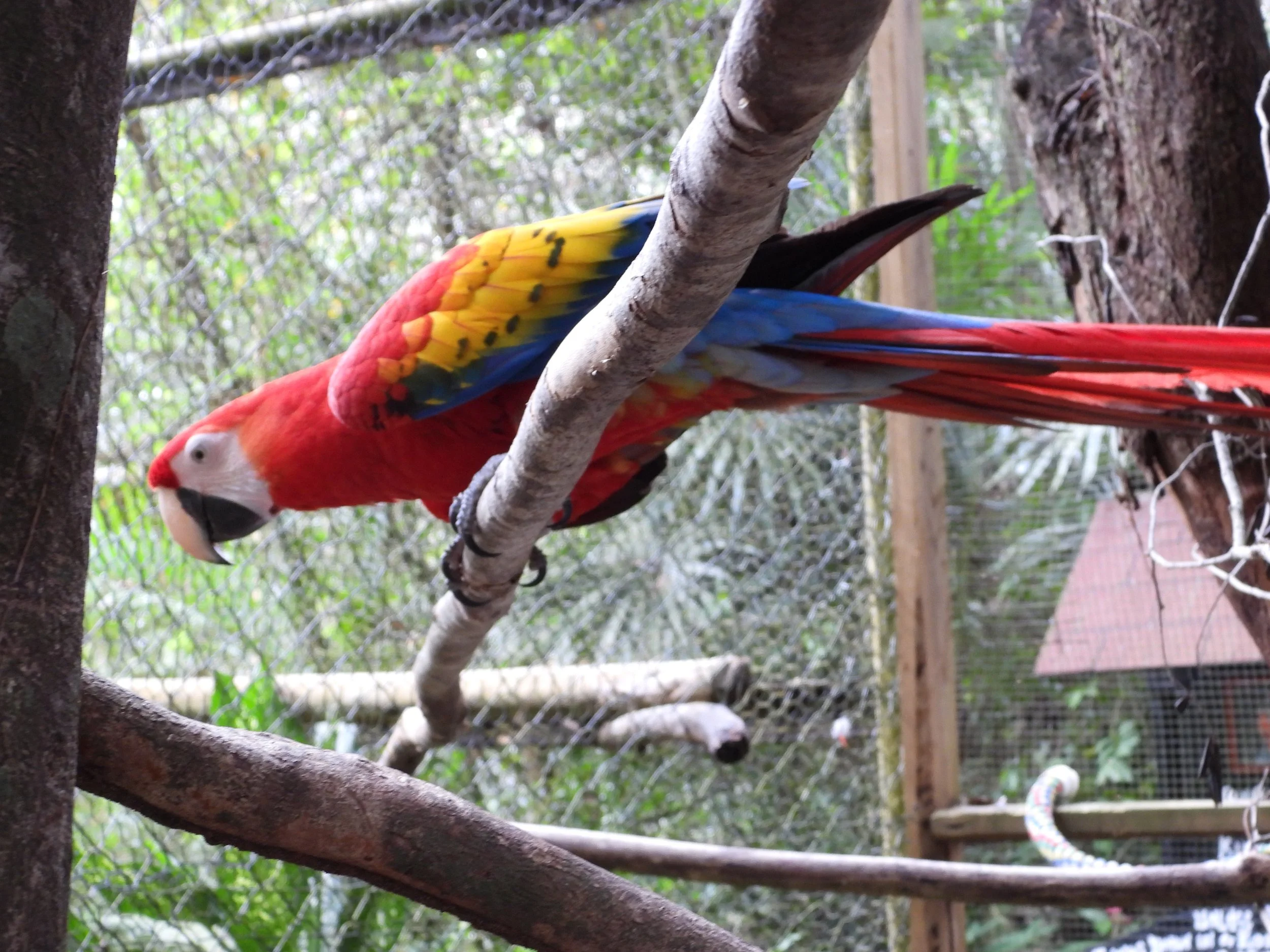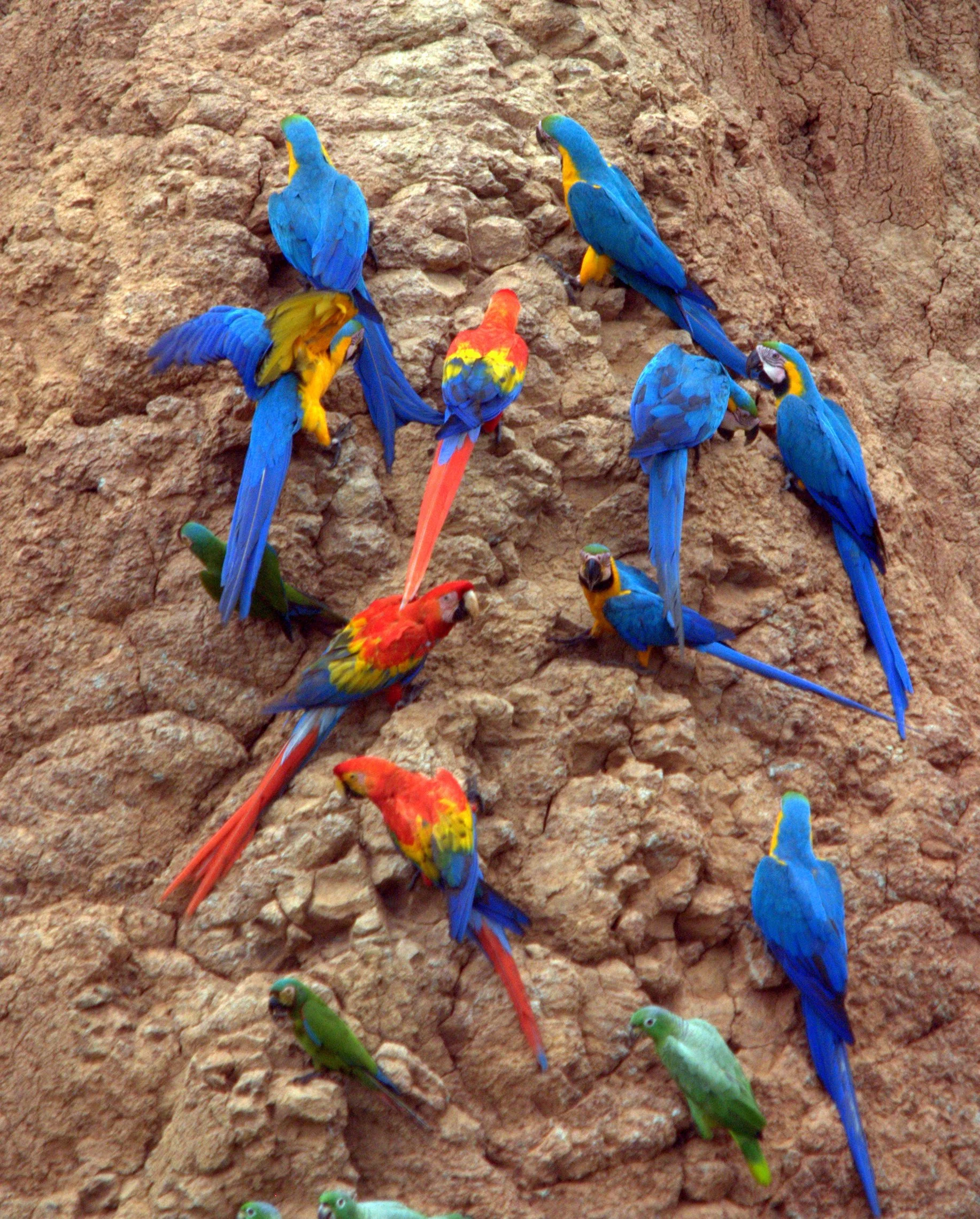Science of Scarlet Macaws
The scarlet macaw (Ara macao) is one of the largest and most recognizable parrot species in the world. Scarlet macaws are easily identified by their bright red coloration, with vivid yellow and blue wing feathers, a white face, and a strong, curved beak. These birds can reach 14 inches (35.5 cm) in length, with long tail feathers ranging from one-third to half the length of the body. Unlike many bird species, male and female scarlet macaws have the same size and coloration.
A scarlet macaw at the Belize Zoo. Image by Inspire EdVentures.
Scarlet macaws are zygodactyl, meaning that their feet have two toes pointing forward and two toes pointing backward, helping them to grip and climb. Zygodactyl feet are also seen in birds such as woodpeckers and owls; interestingly, the structure likely evolved separately multiple times, an example of convergent evolution.
WHERE DO SCARLET MACAWS LIVE?
Scarlet macaws are found in the wild from southern Mexico to northern Bolivia and live in environments from rainforests to subtropical lowlands and savannas. However, scarlet macaws face threats throughout their range. While population strongholds exist in the Amazon rainforest of South America and the Selva Maya of Belize, southern Mexico, and northern Guatemala, other scarlet macaw populations are not so stable. In fact, scarlet macaws may now be extinct throughout most of their former range in Mexico and Central America.
A scarlet macaw in Costa Rica. Image by Satdeep Gill.
In 1994, the Central American scarlet macaw was recognized as a distinct subspecies, Ara macao cyanoptera. Ara macao cyanoptera is identified by color variation, as it is missing the green “stripe” separating yellow and blue wing feathers seen on Ara macao macao, as well as being slightly larger than the South American birds. In his paper identifying the subspecies, Dr. David Weidenfeld of the American Bird Conservancy noted that the Central American scarlet macaw was already extinct in El Salvador, with only small populations found in Belize, Guatemala, Honduras, and Nicaragua. Ara macao cyanoptera was, and continues to be, classified as an endangered subspecies.
WHAT DO SCARLET MACAWS EAT?
A scarlet macaw’s diet consists mostly of fruits and seeds, the latter of which they crack open easily with their large beaks. Their diet makes them important seed spreaders in the rainforest ecosystem. They are also known to eat flowers, insects, and even clay.
Various parrots, including scarlet macaws, at a clay lick in Peru. Image by Brian Ralphs.
Scarlet macaws are diurnal, meaning they are active during the day, and are found most often in the forest canopy or nesting in the hollows of trees. Though it may seem as though their vibrant colors would make them easy to spot, scarlet macaws are actually well-camouflaged among the rainforest’s thick vegetation. Often, these birds are only seen by humans when flying above the canopy or across open spaces.
HOW DO SCARLET MACAWS BEHAVE?
Like most other parrots, scarlet macaws are social birds, living in flocks and communicating to one another with various calls and vocalizations. In captivity, scarlet macaws can even learn to mimic human speech.
A scarlet macaw in Costa Rica. Image by Bernard Dupont
Predators of the scarlet macaw include snakes, large birds such as hawks and eagles, and even monkeys. Animals that are too small to eat an adult macaw may target the birds’ eggs or young instead.
Scarlet macaws are monogamous, meaning that they remain with the same mate for life. Clutches number between one and four eggs, though more commonly one or two. After hatching, young macaws remain with their parents for up to two years, during which time the parents will not lay another clutch. Scarlet macaws live for up to 50 years in the wild, or over 70 years in captivity.
ARE SCARLET MACAWS ENDANGERED?
Though scarlet macaws are listed as Least Concern by the IUCN Red List, this is in large part due to the extent of their range; scarlet macaw populations are decreasing worldwide, and those in Mexico and Central America are notably more vulnerable than those in South America.
Scarlet macaws in Mexico, Central America, and South America all face similar problems: poaching and habitat destruction. The word “poaching” may bring to mind hunting animals for fur, trophies, or meat; however, scarlet macaws are instead poached for sale in the pet trade. Macaw eggs or young hatchlings are even taken from nests and transported out of the country, including to the United States. For scarlet macaw populations as small and threatened as those in Belize and other Central American countries, even small-scale poaching poses an acute danger to the species’s survival in the wild.
Additionally, like many other rainforest residents, scarlet macaws are threatened by habitat loss as the size of Central American and South American rainforests decrease. The IUCN Red List estimates that up to 35% of the scarlet macaw’s current habitat may disappear in the next 38 years, or three generations. Future population decline across the entirety of its range is estimated between 10% to as much as 25% over the next three generations, largely attributed to deforestation of the Amazon rainforest.
Logging in the Iquiri National Forest in Brazil. Image by Erick Caldas Xavier.
So why are scarlet macaw populations in South America classified as Least Concern, while those in Central America and southern Mexico are driven towards extinction? One reason is a phenomenon known as population fragmentation. Fragmentation occurs when populations, groups of animals in the same species, become separated by large distances, often due to interruptions in their natural environments. For some species, population fragmentation can result from interruptions as small as a single road or river dividing a field in two; for others, fragmentation is the result of natural barriers or large-scale environmental destruction.
Small, isolated populations often experience less genetic diversity and greater vulnerability to extinction than large, more interconnected populations. In the case of the scarlet macaw, fragmentation has led to isolated populations in Central America and southern Mexico, and these populations are rapidly declining. In fact, according to the IUCN Red List, scarlet macaws may now be extinct across much of their former Mexican and Central American range.
A Central American scarlet macaw, Ara macao cyanoptera. Image by Charles J. Sharp.
Despite these mounting threats, the fight to save the scarlet macaw is alive and well in Belize. In 1989, less than 30 individual scarlet macaws were believed to exist in the entire country. Today, due to years of conservation, as many as 250 scarlet macaws can be found in Belize, with multiple organizations dedicated to their protection. Inspire EdVentures partners at the Belize Zoo, rescue and care for injured or poached scarlet macaws, with those unable to return to the wild becoming ambassador birds teaching the public about their amazing species.
To learn more about scarlet macaws and support conservation of Belize’s wildlife, visit the Belize Zoo with us at Belize Zoo Live!
REFERENCES AND FURTHER READING
Scarlet Macaws at the Belize Zoo
Scarlet Macaws at the Rainforest Alliance
Scarlet Macaws at BirdLife International
Scarlet Macaws at the IUCN Red List
The Last Flight of the Scarlet Macaw by Bruce Barcott, a novel detailing Belize Zoo founder Sharon Matola’s efforts in protecting Belize’s scarlet macaws






